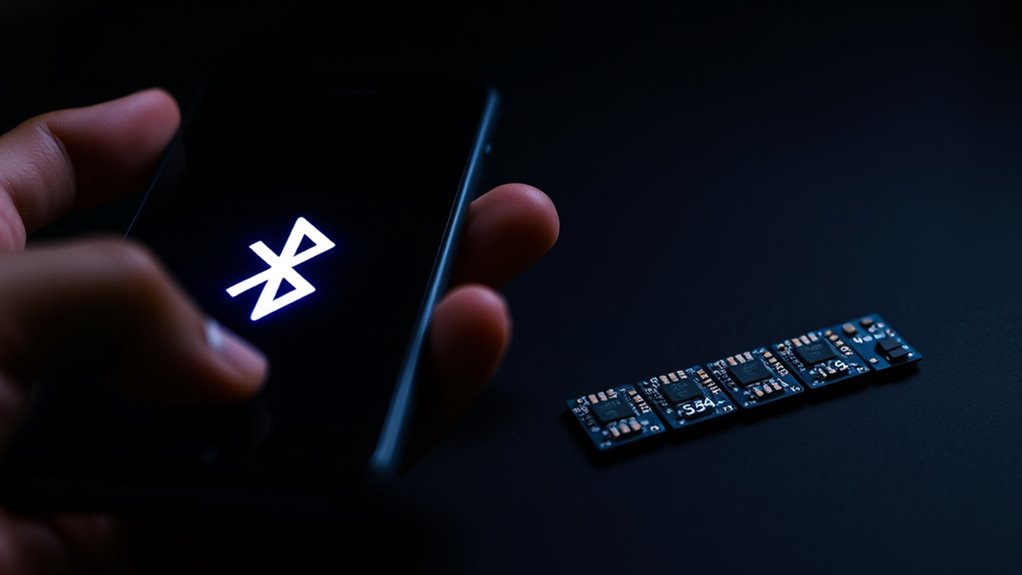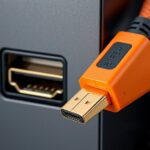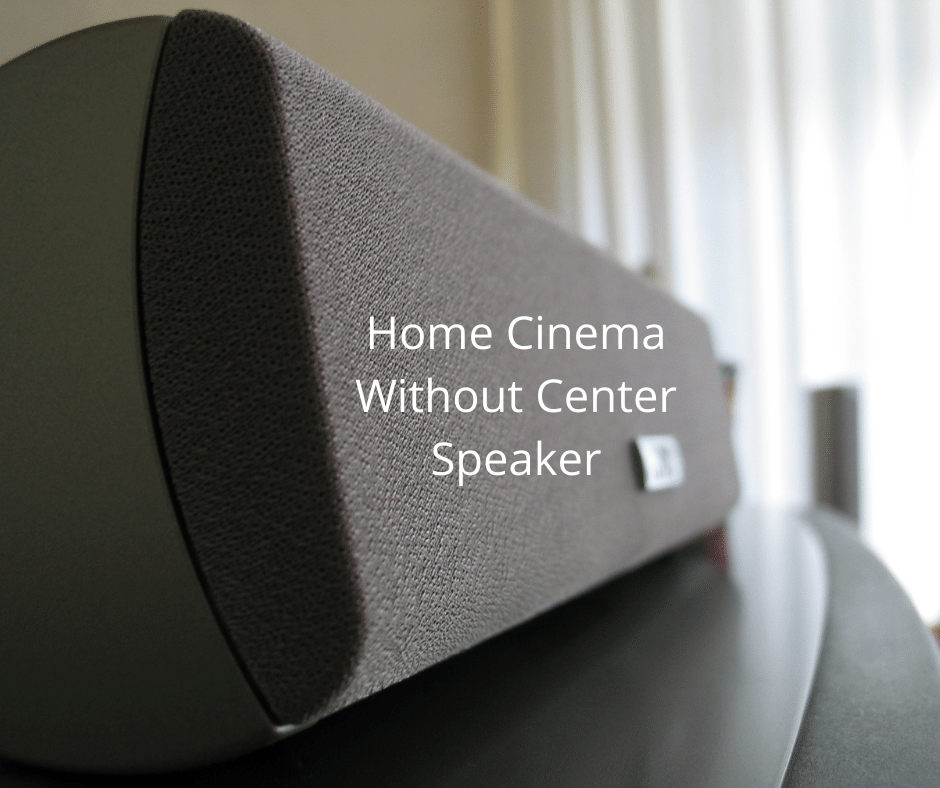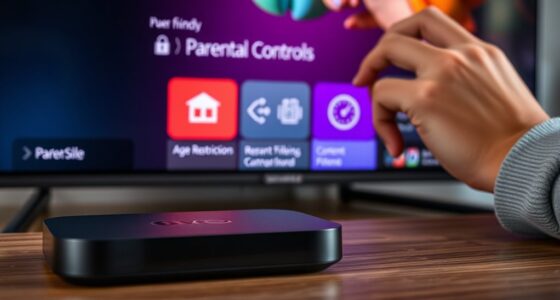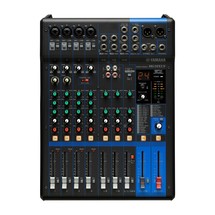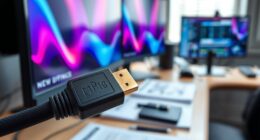Bluetooth versions like 5.0, 5.3, and 5.4 bring better range, faster speeds, and lower power use, making wireless connections smoother and more reliable. Each newer version improves on these features and offers enhanced profile support for high-quality audio and other functionalities. Compatibility is key—newer devices work with older versions, but you miss out on advanced benefits. Continue exploring to understand how these updates can boost your device experience.
Key Takeaways
- Bluetooth 5.0 introduced longer range, faster data transfer, and improved energy efficiency compared to earlier versions.
- Bluetooth 5.3 and 5.4 further enhance power management, connection stability, and support for new profiles.
- Compatibility allows newer Bluetooth versions to connect with older devices, but advanced features require matching versions.
- Key profiles like A2DP enable high-quality audio streaming, supported more fully in recent Bluetooth versions.
- Upgrading to the latest Bluetooth versions maximizes device performance, range, and feature access for beginners.

If you’re new to Bluetooth technology, understanding the different versions can seem overwhelming. The key to making sense of it is recognizing how each version influences the pairing process and device compatibility. When you’re trying to connect your smartphone to wireless earbuds or a speaker, the Bluetooth version on each device plays a vital role. Older versions might still work with newer ones, but they often lack the features and speed of the latest updates. Knowing which Bluetooth version your devices support helps you avoid frustration during setup and guarantees smoother performance.
Understanding Bluetooth versions helps ensure smoother device pairing and better performance.
The pairing process is the first step to connecting Bluetooth devices. With each new version, the process has become more streamlined and reliable. For example, early Bluetooth versions required multiple steps and sometimes involved entering PIN codes. Modern Bluetooth versions, like 4.0 and above, feature simplified pairing, often allowing devices to recognize each other automatically or through quick tap-to-connect methods. This ease of pairing saves you time and reduces connection issues. Additionally, newer versions support faster data transfer during pairing, making the connection process quicker and more efficient.
Device compatibility hinges on matching Bluetooth versions between your devices. If your phone supports Bluetooth 5.0 but your Bluetooth speaker only supports 4.2, they will still connect, but you won’t benefit from the enhanced features offered by Bluetooth 5.0. These features include longer range, faster data transfer, and improved energy efficiency. Conversely, if you try to connect devices with incompatible Bluetooth versions, the connection might fail altogether. To avoid this, check the specifications of your devices before attempting to pair. Most modern devices are backward compatible, meaning they can connect to older Bluetooth versions, but they won’t utilize the advanced capabilities of newer versions unless both devices support those features.
Understanding device compatibility also means recognizing the importance of profiles and supported features. For example, if you want to stream high-quality audio, your device needs to support the appropriate Bluetooth profile, like A2DP. Compatibility isn’t just about the version number but also about the features each device supports. When shopping for new Bluetooth gadgets, look for devices that support the latest Bluetooth versions, especially if you want better range, faster speeds, and improved power efficiency. Moreover, insights from ancient wisdom often remind us that knowledge and learning are crucial for making informed decisions, especially when choosing technology.
Frequently Asked Questions
How Do I Know Which Bluetooth Version My Device Supports?
You can find out which Bluetooth version your device supports by checking its specifications in the user manual or on the manufacturer’s website. Also, look at your device’s settings or system info; sometimes, it displays Bluetooth details. Keep in mind, device compatibility and firmware updates can affect Bluetooth performance, so verify your device is updated to get the latest features and improvements.
Are Newer Bluetooth Versions Backward Compatible With Older Devices?
Sure, newer Bluetooth versions are backward compatible, so your device compatibility should be fine. Just don’t get too excited—sometimes, firmware updates are needed to unseal full features. It’s like giving your old phone a software facelift, but don’t expect miracles if your device is ancient. So, yes, upgrade away, but keep those firmware updates in mind—they’re the secret sauce to seamless Bluetooth harmony.
What Security Features Are Available in the Latest Bluetooth Versions?
The latest Bluetooth versions offer enhanced Bluetooth security through advanced encryption protocols that protect your data during wireless transfers. You benefit from stronger pairing methods like Secure Connections and LE Secure Connections, which prevent unauthorized access. These security features guarantee your devices communicate safely, reducing the risk of hacking or eavesdropping. By keeping your Bluetooth firmware up to date, you can maximize these security benefits and enjoy safer, more private wireless connections.
How Does Bluetooth Version Affect Battery Life of Connected Devices?
Think of Bluetooth versions as the gears in a bike—shifting to a higher gear uses more power, while lower gears save energy. Using newer Bluetooth versions generally reduces power consumption, extending your device’s longevity. You’ll notice that devices stay powered longer when paired with the latest Bluetooth tech, because they’re designed to optimize power use. So, upgrading can help your connected devices last longer and stay efficient on their ride.
Can Bluetooth Versions Influence Data Transfer Speeds Significantly?
Yes, Bluetooth versions can substantially influence data transfer speeds. Bluetooth technology has evolved to offer higher data rates with each new version, allowing faster file transfers and smoother streaming. Upgrading to a newer Bluetooth version improves device compatibility and guarantees you get the best possible data speeds. Keep in mind, though, both devices need to support the same Bluetooth version to maximize transfer performance and take full advantage of these enhancements.
Conclusion
As you explore Bluetooth’s evolving landscape, you’ll find each version subtly enhances your experience, making connections smoother and more reliable. While the differences may seem small at first, they quietly shape how seamlessly your devices work together. Embrace these updates as gentle improvements guiding you towards a more effortless, connected future. In this quiet progression, you’ll discover that sometimes, the smallest changes can open doors to a world of convenience and new possibilities.
